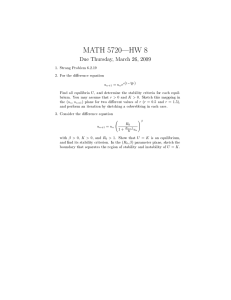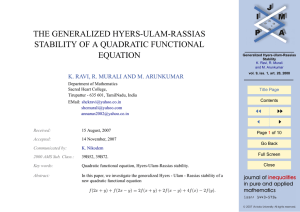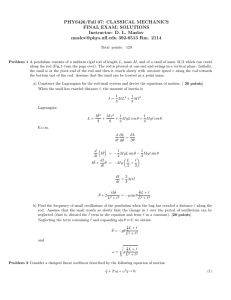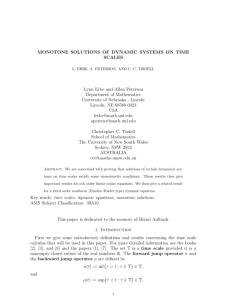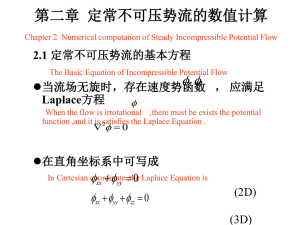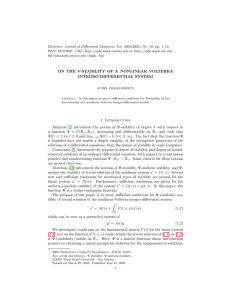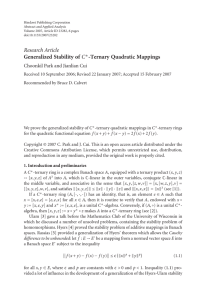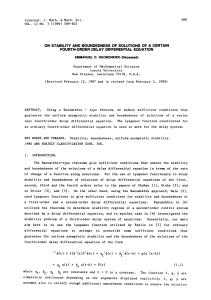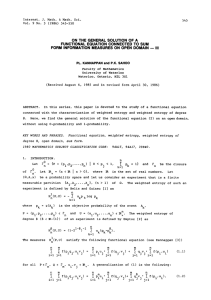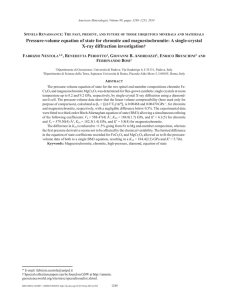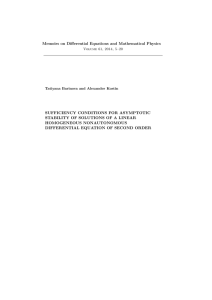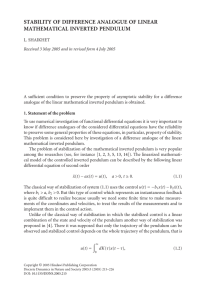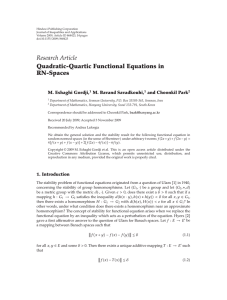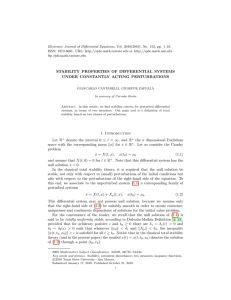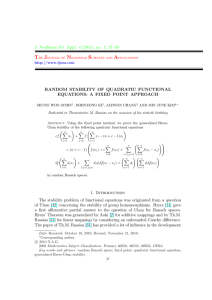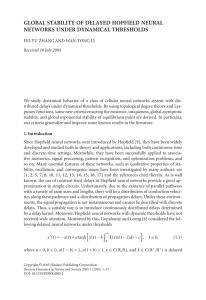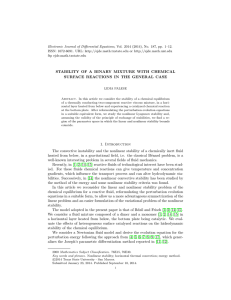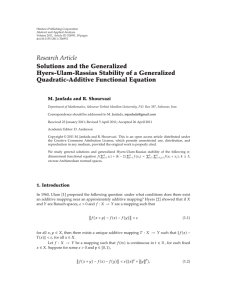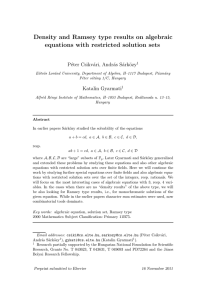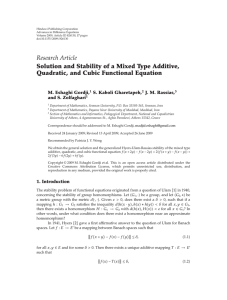Document 10442645
advertisement
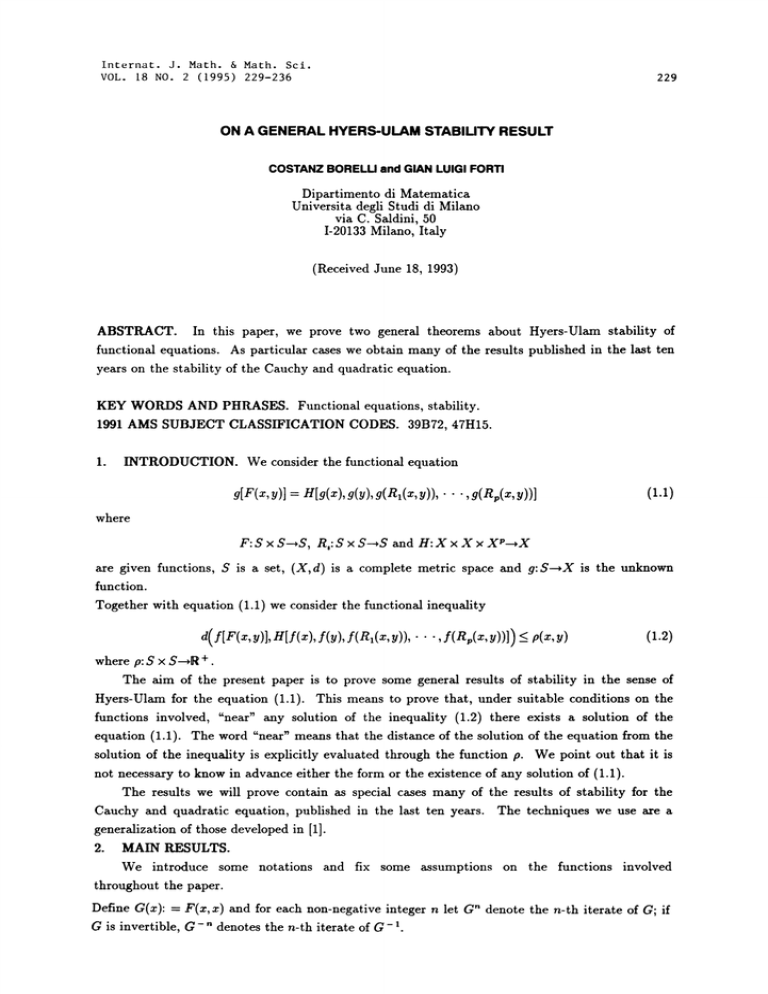
Internat. J. Math. & Math. Sci.
VOL. 18 NO. 2 (!995) 229-236
229
ON A GENERAL HYERS-ULAM STABILITY RESULT
COSTANZ BORELU and GIAN LUIGI FORTI
Dipartimento di Matematica
Universita degli Studi di Milano
via C. Saldini, ,50
1-20133 Milano, Italy
(Received June 18, 1993)
ABSTRACT. In this paper, we prove two general theorems about Hyers-Ulam stability of
functional equations. As particular cases we obtain many of the results published in the last ten
years on the stability of the Cauchy and quadratic equation.
KEY WORDS AND PHRASES. Functional equations, stability.
1991 AMS SUBJECT CLASSIFICATION CODES. 39B72, 47H15.
1.
INTRODUCTION. We consider the functional equation
g[F(x,y)]
H[g(x),g(y),g(Rl(x,y)),
.,g(R,(x,y))]
(1.1)
where
F: S x S-S, R,: S x S-S and H: X x X X’X
are given functions, S is a set, (X,d) is a complete metric space and g:S---X is the unknown
function.
Together with equation (1.1) we consider the functional inequality
d(f[F(x,y)l,H[.f(x),f(y),f(Rl(X,y)),
,f(R,(x,y))]) <_ p(x,y)
(1.2)
where p: S x S--R +.
The aim of the present paper is to prove some general results of stability in the sense of
Hyers-Ulam for the equation (1.1). This means to prove that, under suitable conditions on the
functions involved, "near" any solution of the inequality (1.2) there exists a solution of the
equation (1.1). The word "near" means that the distance of the solution of the equation from the
solution of the inequality is explicitly evaluated through the function p. We point out that it is
not necessary to know in advance either the form or the existence of any solution of (1.1).
The results we will prove contain as special cases many of the results of stability for the
Cauchy and quadratic equation, published in the last ten years. The techniques we use are a
generalization of those developed in [1].
2. MAIN RESULTS.
We introduce some notations and fix some assumptions on the functions involved
throughout the paper.
Define
G(x):
F(x,x) and for each non-negative integer
G is invertible, G-" denotes the n-th iterate of G-1.
n let
G" denote the n-th iterate of G; if
GENERAL HYERS-ULAM STABILITY RESULT
230
We suppose that all functions R,
are constant on the
diagonal of S x S, i.e.,
.,p.
(2.1)
G(R,(x,y)), for i= 1,-..,p.
(2.2)
R,(x,x)=a, ES, forx(Sandz=l,.
Moreover
we assume
that G and
R, commute:
R,(G(x),G(y)
Note that conditions (2.1) and (2.2) iInply that each a, is
a fixed
point of
G:G(a,)=a,,
z=l,...p.
For every z
(z 1,
,z,),
z,
X,
we write
Kz(u):
H(u,u, zl,
.,%)= H(u,u,z)
and assume
By K, j Z,
(2.3)
X and K, invertible.
Kz(X
we denote that j-th iterate
(positive or negative) of K,. In the following, when it is
clear from the context, we shall omit the subscript z.
For a function h:S---X, we denote by h(a) and by h(R(x,y)) the p-tuples
(h( R(x, y)),
h(R,(x, y))) respectively.
For a function f: S--X we define for all x,y S
.,
5(x,y):
d
,f(R,(x,y))])
(f[F(x,y)l,H[f(x),f(y),f(R,(x,y)),
5(x,z).
PROPOSITION 1. Let f:SX be
(h(a),...,h(a,))and
and A(x):
a function
and assume the following conditions are
satisfied:
(i) defined K(u):
k:R +-R + such that
g[u,u,.f(a)], there exists
Vu, v e Z
(ii)
a strictly increasing superadditive function
(2.4)
k(d(u,v))
d(K(u),g(v))
X
the function H is continuous and for every u
(2.5)
H[K-’(u),K-’(u),K-’(I(a))] K-’[H(u,u,f(a))]
where
,K- ’(f(%)).
(K- (f(a,,)),
K-’(j(a))
k-’*[A(G"-’(x))] converges for every z ( S, then the sequence
If the series
n=l
q.(x):
converges for every x e S and defined g(x):
g[G(x)]
K-’[f(G"(x))]
l,,im q,(x),
we
have
H[g(x), g(x), g(a)].
Moreover the following conditions hold
k-"[A(G"-’(x))],
d(g(x),f(x))<_
lira
It’-"
(K(o) [g(x)])= g(x),
x
xCS,
(2.8)
S.
(2.9)
(2.7)
The function g is the only solution of
satisfying (2.8) and (2.9).
PROOF. As fit step we vute the distance between
introduce the following notations:
f[G"(x)] and K"[f(x)]. We
k,(t): =k(t),k,(tl,..-,t,,): =k[t,Tk.,_,(t,,...,t,_,)],t,a +,
m> 1.
C. BORELLI AND G. L. FORTI
231
We prove by induction that the following inequality
d( f[G"( z)], K"[f x)])
holds. Take n
d
A(G
l(x)) t_ n-I(A(X),
(2.10)
2; we have
(f[G(x)], K:[f(x)])<_ d (f[G:(x)], K[f(G(x))])+ d (K(f[G(x)]), K[f(x)]) <_
< d (f[a(x)], H[f(G(x)), f(G(x)), /(a)])+ k [d (f[G(x)], K[f(x)])]
A(G(z))+ [d (f(G(z)), H[f(x), f(z),
Assume now (2.10) is true for
d
,A( Gn- 2(x)))
/(a)])]
A(G(z))+
n- 1; we obtain
(f[G"(x)], K"[f(x)])<_ d (f[G"(x)],
K[f(G"-I(X))])-"3t- (I[f(Gn-l(x)>], /’"[f((.))])= (en-l(z)) +
"
+
A(G"-
{(a--()) +
,_
[d( f[Gn-l(z)], /<n- ’[f(z)])]
, a(a-- ())]}
[a(x),
a(a"-1())+ ,_l[a(),..., (a"-())].
(To prove the lt inequality, remember that k is increasing).
In the next step we use inequity (2.10) to show that {q,(x)}
completeness of X it is convergent.
Let n > m, then
d (q,,(x), q,.,,(x))= d (K-"[f(G"(x))],
is a Cauchy sequence; thus by the
K-’[f(GO’(x))])=
k-" [d(f[G"(x)],
t
K"-"[f(G"(z))])
since k is increasing and superadditive, k-" is increasing and subadditive, so we get by (2.10)
d (q,(x), q,(x))< k
{A(G"-’(x))+ k
-,A(G"-2(x))]} _<
[A(G’(x)),
n
j=m+l
the convergence of the series
n
every x E S.
Define g(x): =/.irn q.(x); we have
d
is a Cauchy sequence for
(K-"[f(G"+’(x))], U[K-"(f(a"(x))), K-"(f(a"(x))), K-"(f(a))])---,
d (giG(x)], gig(x), g(x), g(a)])for n--o
(note that G"(a,) a,);
d
k-"[A(G"-’(x))] implies that {q,(x)}
on
the other hd we get
(K-"[f(G"+(x))], g[g-"(f(G"(x))), g-"(f(G"(x))), K-"(](a))])=
d (g-"[f(G"+(x))], g-"[g(f(G"(x)), f(G"(z)), f(a))])
k-" [d (f(G "+ (x), H(I(G"(x)), f(G"(x)), f(a)))] k-" [&(G"(x))]0
-
-
for n; thus we obtain (2.7).
d (q,(x), f(x))= d (K-" [f(G"(x))], f(x))= k-" [d (f(G"(x)),
< -n{A( Gn- l(x)) ]n-I[A(x),
taking the limit
as n
,A( Gn- 2(x))]}
goes to infinity we have (2.8).
K"[f(z)])]
n
Z k- 3[A(G.1- l(x))],
3=1
232
GENERAL HYERS-ULAM STABILITY RESULT
Assume h is
a function
satisfying (2.8), i.e.,
d
--"
(h(), f())_<
xES.
Then for every s E N we have
k-"[A(G"+’-’(x))l
d(h[G’(x)],f[G’(x)])<
n=l
and, by (2.4),
k"
{d (K-S[h(GS(x))], K-S[f(G’(x))])} <
k-’*
[/(en+s-l(x))],
n=l
d (K- S[h(G’(x))], K- s[f(G’(x))]) <
k-m[A(Grn-l(x))]
m=s+l
Taking the limit as s---oc, we get
KSince g is a solution of
xES.
(2.11)
(2.7), we have
K,(o)[g(x)] and K-’{g[G"(x)]} K-"{K(,,)[g(x)]};
by (2.11), since g satisfies (2.8), we get K-"{K(o)[g(x)]}---,g(x), i.e., (2.9).
If h is a solution of (2.7), then K-"{h[G"(x)]} g-"{g,(o)[h(x)]} and if h satisfies (2.9), we get
1"!
g-"{g,(o)[h(x)]}---h(x). This and (2.11)imply h g.
giG’S(x)]
A similar result can be obtained under different assumptions on the functions G and K.
PROPOSITION 2. Let f:S---.X be a function and assume the following conditions
are
satisfied:
H[u,u,f(a)], there
(i) defined g(u):
k: I + ---+1 + such that
Vu, v X
(ii)
exists a strictly increasing subadditive function
d(K(u),K(v))
the function H is continuous and for every u
(2.12)
k(d(u,v))
X
H[K(u), K(u), K(f(a))] K[H(u, u,/(a))]
(2.13)
where
K(f(a))
(K(f(a,.,)),
,K(f(ap))).
(iii) the function G is invertible.
k"-I[/(G-n(x))] converges for every x e S,
If the series
then the sequence
n=l
IC"[f(G-"(x))]
p,(x):
converges for every x e S and defined g(x):
(2.7).
l.m p,,(x),
(2.14)
the function g is a solution of equation
Morver he following conditions hold
d (g(x),
f(x))
k "-’[A(G-"(x))],
x
e S,
n=l
,-tm K (’-. [a()])= a(),
x
e S.
(2.15)
(.)
The function g is the only solution of (2.7) satisfying (2.15) d (2.16).
PROOF. The prf follows step by step that of Proposition 1. After the evaluation of the
distce between f[G-’(z)] and K-’[f(z)l one proves that {p,(x)} is a Cauchy sequence
for
C. BORELLI AND G. L. FORTI
233
every x E S, and thus is convergent. So we inmediately obtain (2.7) and (2.15).
Also for the uniqueness we proceed as in Proposition 1.
REMARK 1. Note that in Propositions and 2, only the function A(x) has been used, so
they are stability theorems in the sense of Hyers-Ulam for the functional equation in a single
variable (2.7). The special case of the equation g(2x)= 2g(x) (where ,r belongs to a semigroup
and the values of g are in a Banach space) with A(x) < const follows immediately from [2] and is
presented in [3]. The stability of the equation g(2z)= 4g(z) (x in a group and g(x)in a Banach
space) again with A(z)5 const, is contained in [4].
REMA 2. In Proposition 1, in order to have the convergence of the series
k-"[(G"(z))], it is enough to require that the function k satisfies the inequality k(t) ct for
some c > and that the series E c-"(G"-(x))is convergent. An analogous remark holds for
Proposition 2.
is a topological space, F d f e continuous functions. The
function k in Proposition 1 is continuous at 0, so from d(K-l(u),K-l(v))= k-l(d(u,v))we get
the continuity of K-1. It follows that q,: SX is a continuous function for every n G N. We c
conclude that if for each point z S there is a neighborhood U 9 x such that the series
MA 3. Assume S
converges uniformly on U, then the function g is continuous on S. Note
that this happens when the sup{(G"-x(z)):n 1,x S} < +. An analogous remk holds
for Proposition 2, where we need the continuity of the function G-1.
The next two theorems give results of stability for the functional equation (1.1). Essenti
d 2 and now a fundamentM role is assumed by the "gebrc"
tls e Propositidns
properties of the functions F and H.
THEOM 1. Assume that 1 hypotheses of Proposition e satisfied. Moreover suppose:
k-"[(G"-l(z))]
Vx, y e S,
Vu, v e X,z
(z,
F[F(x,y), F(x,y)]
F[F(x,x), F(y,y)]
(2.17)
,%) X
g-l[g(u,v,z)]
w, s,
g[g-(u),g-(v),g-(z)]
--((v-(), v-())0 s
..
(2.18)
(e.)
Then the function g defined in Proposition 1 is a solution of the functionM equation (1.1).
PROOf. We recall that g(x): lira K-"[f(G"(x))]. For every x,y e S, by (2.2), (2.17),
(2.18) and the continuity of H we have
d (g-’{f[f(G"(x), V"(y))]}, g-"{g[f(G"(x)), f(G"(y)),
f(R(G"(z), G"(y)))]})=
=d (g-"{f[G"(f(x,y))]},
K-"{H[f(G"(x)), f(G"(y)), f(G"(R(x,y)))]})=
d (q.(f(,)), g[q.(),q.(), q.(R(,))])
d
On the other hd,
we have
(g[F(x,y)], H[g(x), g(y), g(R(x,y))])
Mso
d (K-"{f[F(G’(x), G"(y))]},
K-’{H[f(G"(x)), f(G’(y)), f(R(G’(x), G"(y)))]})=
k-’{d (f[F(G"(x) G"(y))], H[f(G’(x)), f(G"(y)), f(R(G"(x), G"(y)))]})}
k-"(6(G"(x), G’(y)))-- 0 as n--cx, by (2.19).
Thus the theorem follows.
234
GENERAL HYERS-ULAM STABILITY RESULT
THEOREM 2. Assume that all hypotheses of Proposition 2
Vx, y S,
Vu, v X, z=(zl,
F[F(x,y), F(x,y)]
Moreover suppose:
are satisfied.
F[f(x,x), F(y,y)]
.,z v) X
K[g(u,v,z)]
Vx, y
g[K(u),K(v),K(z)]
s, --(6(--(x), --()))- 0
.
Then the function g defined in Proposition 2 is a solution of the functional equation (1.1).
PROOF. The proof is completely similar to that of Theorem 1.
REMARK 4. In algebraic language, the set S with the operation F is a groupoid and in the
proofs of both Theorems and 2 we do not need power associativity of S as, for instance, in [5].
Conditions (2.17) and (2.18) give the inequalities
F[G"(x),G"(y)]
G"[F(x,y)], x,y S,
n
K-"[H(u,v,z)]= H[K-"(u), K-"(v), K-"(z)], u,v X,
which are used in the proof of Theorem 1.
If we stipulate the following conditions, there exists v
f[G"(x), G"(y)]
g-"[g(u,v,z)]
I,
z
X
,
n
.
(2.20)
(2.21)
> 2 such that
G"[f(x,y)], z,y S,
g[g-"(u),g-"(v),g-"(z)],u,v X,z X
(2.22)
,
(2.23)
,
it is easy to prove by induction that relations (2.20) and (2.21) hold for all n of the form v
s I, and this is sufficient for proving Theorem
(see for related questions [5] and [6]). Note
that (2.22) is strictly weaker than (2.17). To see this take as (S,F) the dihedral group D4: (2.17)
is not true while (2.22) holds for v 2.
A similar remark holds for Theorem 2.
The special case when H depends only on its first two variables, i.e. when (1.1) becomes
g[F(x, y)]
H[g(x), g(y)],
(2.24)
has been treated in [1], where examples and counterexamples are presented.
When X is a Banach space, equation (2.24) generalizes the additive Cauchy equation
g[F(x,y)]
g(z) + g(y)
(2.25)
and if p(x,y)= const, Theorem 1 gives the well known Hyers result (see [2]).
Also, if S is a normed space and F is its addition, we obtain, for various forms of p(x,y) and
using either Theorem or Theorem 2, many of the results on stability published in the last years.
More precisely:
o _< + b <
(Th. 1)" see [17] and [6];
,o(=, y)
= II" y
,
’(=, y)
(
= "+
,,
% ,<
y
o(
= II,
y
),
see
[18],
[10];
(Th. 2)" see
where (I):a + xR +-*R + is increasing,
a>l
p(=, y)
(Th. 1)"
-
symmetric and homogeneous of degree p [0, + oo)\{1} (Th. 1, Th. 2): see [20];
0 as --, 0,
p(x,y)=c (*( x + q( y )), where *:R +-- R + is such that t-l*(t)
fft(ts) <_ (t)*(s), *(t)< for > (Th. 1): see [7].
Note that also a particular case of a stability result abou’t set-valued functions, due to Smajdor, is
contained in Theorem for equation (2.24) (IS], []).
C. BORELLI AND G. L. FORTI
X B be a Banach space on K (K is R or C) and let a, b, o, /L ",, .,’p E K with
Let r,’B-oB,, 1, .,p, be functions satisfying the functional equation
(a + b)ch(t) and define R,(x,y) ,’,(x- y).
Let S
a
+b
235
1.
((a + b)t)
Consider now the functional equation
p
g(ax +by)= og(x) + ,:tg(y) +
and let
f: B--,B be a function with f(0)
0 such that
f(ax + by)- af(x)- 3f(y)for all x, y E B, where
By using Theorems
a
+bl’l + 1
[10] and [11]).
-
#
v > 0 and
P
(2.26)
",g(n,(x.y))
z=l
,f(R,(x,y))II < 0(
I1" /
")
(2.27)
R.
and 2 we obtain tile stability of equation (2.26) under the condition
in general we have no stability" see
(In tile case a +bl’la +/3 -1
Note that the condition f(0)= 0 cannot be dispensed with, otherwise conditions (2.5), (2.13),
(2.18) and the analogous of Theorem 2 are not satisfied.
Nevertheless when
the function f*(x)= f(x)-f(O) satisfies the inequality (2.27), so we
+ +3’ +’’" + %
can apply Theorems 1or 2 to it. In the case +/3+-1+--. +7,#1, if s>0 the condition
f(0)=0 is forced by (2.27) if s<0 the function f* satisfies (2.27) with
a+ +/+
+ %- 11 f(0)II + *( x II’+ Y ) as the right-hand side, so again we can
a
apply Theorem 1.
Note that equation (2.26) when a =b= 1,a
2,p= 1, 3’1
-1 and r(t)= becomes
the quadratic equation and our results contain as particular cases those in [2], [13], [14], [4].
If in (2.27) instead of
I1" + II" we have the quantity x II’ll q, we obtain the
stability under the condition a + b 1 + a +/3
# 1. In the case of the quadratic equation we
obtain as a particular case the result in
[15].
A SEPARATION THEOREM.
In the last section we assume X is a closed subinterval of R. By using the stability results
we can prove a separation theorem (for analogous results see [16]).
Assume f,g:SX are functions such that
3.
_
< f(x)
H[g(x),g(y),g(R(x,y))] < g[F(x,y)] <_ f[F(x,y)] < H[f(x),f(y),f(R(x,y))]
for all x,y S. We ask whether there exists a function h:S--X solution of equation
separating f and g, i.e., such that
g(z) < h(x) < f(x),
_
x
S.
(3.1)
(1.1)
(3.2)
We prove that under the hypotheses of Theorem (or Theorem 2) with some additional
conditions on the functions involved, the answer is affirmative.
THEOREM 3. Let f,g:SX be functions satisfying (3.1) and such that f(a)= g(a). Define
H[f(x), f(y), f(R(x,y))]-H[g(x), g(y), g(R(x,y))], x,y e S.
Under the hypotheses of Theorem (Theorem 2) where instead of i we write a, and if K is
strictly increasing on X, there exists a function h:S--X solution of (1.1) such that
g(x) h(x) < f(x) for all x S.
a(x,y)
PROOF. We prove the theorem under the assumptions of Thecrem 1. By the hypothesis
on a we can conclude that the sequence {K-"[I(G"(x))]} converges and its limit, suy h(x), is a
solution of equation (1.1).
236
GENERAL HYERS-ULAM STABILITY RESULT
By hypothesis, the functiou If(u)= H[u,,,,f(a)]= H[u, u, g( a)]
is increasing.
This and
(3.1)
imply f(G"(z)) < K"(f(x)), so we get K-"[f(G"(x))] < f(x) and h(x) < f(x). Moreover we have
g(x) < K-"[g(G"(x))] < K-"[f(G"(x))] and so g(x) < h(x).
REFERENCES
FORTI, G.L., An existence and stability theorem for a class of functional equations,
Stochastica 4 (1980), 23-30.
2. ttYERS, D.H., On the stability of the linear functional equation, Proc. Nat. Acad. Sci.
U.S.A. 27 (1941), 222-224.
3. FORTI, G.L., The stability of homomorphisms and amenability, with applications to
functional equations, Abh. Math. Sere. Univ. Hamburg 57 (1987), 215-226.
4. SKOF, F., Proprieta locali e approssimazione di operat6ri, Rend. Sere. Mat. Fis. Milano 53
(1983), 113-129.
5. R.,TZ, J., On approximately additive mappings, in General Inequalities 2, ISNM 47,
Birkhuser, Basel (1980), 233-251.
6. TABOR, J., 18. Remark, in Report of 22nd ISFE, Aequationes Math. 29 (1985), 96.
7. ISAC, G. and RASSIAS, Th.M., On the Hyers-Ulam stability of C-additive mappings, J.
Approx. Theory 72 (1993), 131-137.
8. GER, R., 25. Remark, in Report of 28th ISFE, Aequationes Math. 41 (1991), 295.
9. SMAJDOR, A., Hyers-Ulam stability for set-valued functions, in .Report of 27th ISFE,
Aequationes Math. 39 (1990), 297.
10. GAJDA, Z., On stability of additive mappings, Internat. J. Math. and Math. Sci. 14 (1991),
1.
431-434.
11. RASSIAS, Th.M. and EMRL, P., On the behaviour of mappings which do not satisfy
Hyers-Ulam stability, Proc. Amer. Math. Soc. 114 (1992), 989-993.
12. CHOLEWA, P.W., Remarks on the stability of functional equations, Aequationes Math. 27
(1984), 76-86.
13.
DRLJEVI(, H.,
14.
FENY(, I., On
15.
16.
17.
18.
On the representation of functionals and the stability of mappings in
Hilbert and Banach spaces, in Topics in Mathematical Analysis, Th.M. Rassias (Ed.),
World Scientific Publ. Co., Singapore 1989, 231-245.
an inequality of P.W. Cholewa, in General Inequalities 5, ISNM 80,
Birkh/iuser, Basel (1987), 277-280.
RASSIAS, J.M., On the stability of the Euler-Lagrange functional equation, C.R. Acad.
Bulgare Sci. 45 (1992), 17-20.
GAJDA, Z. and KOMINEK, Z., On separation theorems for subadditive and superadditive
functionals, Studia Math. 100 (1) (1991), 25-38.
RAS;IAS, J.M., Solution of a problem of Ulam, J. Approx. Theory 57 (1989), 268-273.
RASSIAS, Th.M., On the stability of the linear mapping in Banach spaces, Proc. Amer.
Math. Soc. 72 (1978), 297-300.
